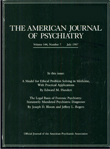One-Year Follow-Up of Survivors of a Mass Shooting
Abstract
OBJECTIVE: This report describes a 1-year follow-up study of survivors of a mass shooting incident. Acute-phase data from this incident were previously reported in this journal. METHOD: The Diagnostic Interview Schedule/Disaster Supplement was used to assess 136 survivors at 1–2 months and again a year later, with a 91% reinterview rate. RESULTS: In the acute postdisaster period, 28% of subjects met criteria for posttraumatic stress disorder (PTSD), and 18% of subjects qualified for another active psychiatric diagnosis. At follow-up, 24% of subjects reported a history of postdisaster PTSD (17% were currently symptomatic), and 12% another current psychiatric disorder. Half (54%) of all 46 individuals identified as having had PTSD at either interview were recovered at follow-up, and no index predictors of recovery were identified. There were no cases of delayed-onset PTSD (beyond 6 months). Considerable discrepancy in identified PTSD cases was apparent between index and follow-up. Inconsistency in reporting, rather than report of true delayed onset, was responsible for all PTSD cases newly identified at 1 year. The majority of subjects with PTSD at index who were recovered at follow-up reported no history of postdisaster PTSD at follow-up, suggesting considerable influence of fading memory. CONCLUSIONS: This study's findings suggest that disaster research that conducts single interviews at index or a year later may overlook a significant portion of PTSD. The considerable diagnostic comorbidity found in this study was the one robust predictor of PTSD at any time after the disaster. Disaster survivors with a psychiatric history, especially depression, may be most vulnerable to developing PTSD and therefore may deserve special attention from disaster mental health workers. (Am J Psychiatry 1997; 154:1696–1702)



